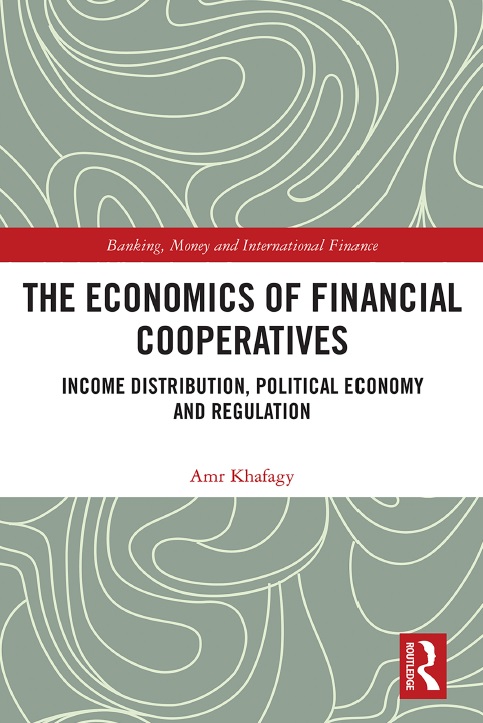by Amr Khafagy

Contents
List of figures ix
List of tables xi
Acknowledgements xiii
List of acronyms xv
1 Introduction: why financial cooperatives matter now 1
1.1. Introduction 1
1.2. Financialization, distribution, and the political
economy of finance 2
1.3. Financial cooperatives for egalitarian development 8
1.4. Avoiding an idealisation trap 9
Bibliography 11
2 Finance, distribution, and the economic objective of financial
cooperatives 14
2.1. Introduction 14
2.2. Model setup 18
2.3. Income and wealth distribution with credit rationing 22
2.4. Income and wealth distribution with financial cooperatives 28
2.5. Financial cooperative economic objective function 33
2.6. Concluding remarks 35
Bibliography 36
3 Financial cooperatives and income inequality: empirical evidence 39
3.1. Introduction 39
3.2. Finance and income inequality 40
3.3. Data and method 44
3.4. Results 48
3.5. Concluding remarks 56
Bibliography 56
4 Political economy theory for financial cooperative development 59
4.1. Introduction 59
4.2. Political history of financial cooperatives 59
4.3. A political economy theory of financial cooperatives 61
4.4. Concluding remarks 69
Bibliography 70
5 Political institutions and financial cooperative development:
empirical evidence 73
5.1. Introduction 73
5.2. Data and method 75
5.3. Results and discussion 79
5.4. Conclusion 86
Bibliography 86
6 The origin and rationale for financial cooperative regulation in
underdeveloped economies 88
6.1. Introduction 88
6.2. The historical origins of financial cooperative laws in
underdeveloped economies 90
6.3. Current models of financial cooperative laws 91
6.4. Rationale for financial cooperative regulations 93
6.5. Conclusion 104
Bibliography 105
7 Regulation, supervision, and deposit insurance for financial
cooperatives: an empirical investigation 108
7.1. Introduction 108
7.2. Regulation, supervision, and deposit insurance for
financial cooperatives 109
7.3. Data and method 114
7.4. Results and discussion 125
7.5. Conclusion 132
Bibliography 134
Discussion and conclusions 137
Appendix 139
Bibliography 141
Index 175
Tables
3.1 Empirical literature on the effect of the financial sector on
income inequality 41
3.2 Data sources and variables used 46
3.3 Data description 47
3.4 Fixed-effects regression results for gross Gini coefficient
against share of financial cooperatives’ credit in the credit
and financial markets 49
3.5 Fixed-effects and two-stage instrumental variable
regression results for change in gross Gini coefficient
against change in the share of financial cooperatives’ credit
in the credit and financial markets 51
3.6 Fixed-effects regression results for change in gross
Gini coefficient against change in the share of financial
cooperatives’ credit in the credit and financial markets
(clustered by the size of financial market) 54
3.7 Fixed-effects regression results for change in the share of
financial cooperative credit in the total domestic credit and
financial market against change in gross Gini coefficient
(reverse regression) 55
5.1 Information on the data sources and variables used 77
5.2 Data description 79
5.3 Pairwise correlation coefficients among the dependent,
explanatory, and instrumental variables 80
5.4 Fixed-effects OLS regression results for financial
cooperatives indicators against democracy, political rights,
and civil liberties indices (underdeveloped economies
1995–2014) 81
5.5 Fixed-effects IV 2SLS regression results for financial
cooperatives indicators against democracy, political rights,
and civil liberties indices (underdeveloped economies
1995–2014) 82
7.1 Regulation and supervision approaches of financial
cooperatives in 1995 vs 2014 110
7.2 Data description 114
7.3 Information on the data sources and variables used
in the analysis 115
7.4 Fixed-effects regression results for financial cooperatives
indicators and regulations 119
7.5 Fixed-effects regression results for financial cooperatives
indicators and supervision 125
7.6 Fixed-effects regression results for financial cooperatives
indicators and deposit insurance 130
A3.1 List of countries included in the analysis 142
A5.1 List of countries included in the analysis and main
indicators as of 2011 (in %) 143
A5.2 OLS regression results for financial cooperatives indicators
against democracy, political rights and civil liberties
indices (underdeveloped economies 1995–2014) 144
A7.1 Random-effects regression results for financial
cooperatives indicators and regulations 146
A7.2 Random-effects regression results for financial
cooperatives indicators and supervision 152
A7.3 Random-effects regression results for financial
cooperatives indicators and deposit insurance 158
A7.4 List of regulations reviewed 160
A7.5 List of supervisory authorities and deposit insurance schemes 169
Figures
1.1 Domestic credit and top 1% share of pre-tax income (global) 4
1.2 Domestic credit and top 10% share of pre-tax income (global) 4
1.3 Market capitalization of listed domestic companies and top
1% share of pre-tax income (global) 5
1.4 Market capitalization of listed domestic companies and top
10% share of pre-tax income (global) 5
2.1 Wealth per income class with financial sector dominated by
investor-owned
bank 26
2.2 Wealth per income class with diversified financial sector
(investor-owned bank and financial cooperative) 31
